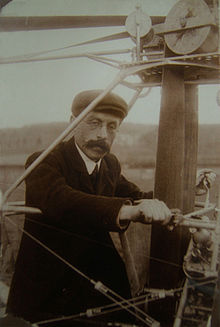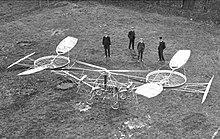Paul Cornu
Paul Cornu (born June 15, 1881 in Glos-la-Ferrière , Orne , France ; † June 6, 1944 in Lisieux ) was a French engineer who actually manufactured bicycles.

Cornu developed the world's first manned helicopter , called Cornu No. II , called the flying bicycle . During the first flight on November 13, 1907 in Lisieux, it reached a height of about 30 cm and a flight time of 20 seconds.
Of the 260 kg helicopter was supported by a V8 - Otto engine the Société Antoinette with 24 PS driven power, the opposite direction about a central axis by means of two belt vane type. This design, in which the torques of the two rotors balance each other, was later used as a tandem configuration on a number of helicopters.
However, the flying bike turned out to be not controllable and so it was abandoned after a few flights.
Previously, another French helicopter, the Bréguet-Richet I, managed to take off through its own performance - but since it was held in position by men on the ground, Cornus Flug is considered the first free flight of a helicopter.
Cornu died on June 6, 1944 when his house was destroyed during the bombing to land in Normandy , Operation Overlord . Mount Cornu , a mountain in the north of the Antarctic Peninsula, is named in his honor .
Replica
On the occasion of the 100th anniversary of Paul Cornu's first flight on November 13, 2007, a non-airworthy replica of Cornu No. II in its original size was completed in the helicopter museum in Bückeburg and taken over into the museum's permanent exhibition.
literature
- Engelbert Zaschka : rotary wing aircraft. Gyroscopes and helicopters. CJE Volckmann Nachf. E. Wette, Berlin-Charlottenburg 1936, OCLC 20483709 .
Web links
- US Centennial of Flight (another picture)
- Replica of the Cornu No. II in original size in the helicopter museum in Bückeburg
- Eurocopter Paul Cornu
| personal data | |
|---|---|
| SURNAME | Cornu, Paul |
| BRIEF DESCRIPTION | French engineer and helicopter designer |
| DATE OF BIRTH | June 15, 1881 |
| PLACE OF BIRTH | Glos-la-Ferrière , Orne department , France |
| DATE OF DEATH | June 6, 1944 |
| Place of death | Lisieux |

